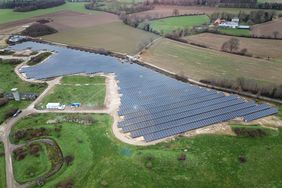
Solar power for Xanten
Xanten/Essen/Würzburg. STEAG Energy Solutions (SENS), the Würzburg-based subsidiary of energy company STEAG in Essen, has constructed a solar farm on the site of the former NATO rocket base in Xanten, North Rhine-Westphalia. Where air defense missiles equipped with nuclear warheads were stationed until 1989 under the command of the Belgian armed forces, the solar farm now generates around 4.4 million kilowatt hours (kWh) of climate-neutral green electricity annually for the Lower Rhine region.
With the successful completion of the project, investor ENNI Solar GmbH, a subsidiary of Moers-based regional utility ENNI Energie & Umwelt GmbH, is adding 4.35 megawatts (MWp) to its renewable power generation portfolio. Construction began in October 2021, and since then SENS, with the support of SOL IN ONE GmbH, has installed nearly 10,000 solar panels on the site and now connected the photovoltaic system to the grid.
In arithmetical terms, the new solar farm can cover the annual electricity needs of around 1,250 households. This will permanently save around 1,625 metric tons of CO2 emissions each year. With this successfully completed PV project, the Lower Rhine region is making an important contribution to achieving climate targets and to the success of the energy transition as a whole.
Rough terrain
“From planning through construction of the plant to commissioning, we took on the implementation of the project as an EPC contractor for ENNI, overcoming the almost impassable terrain at the site,” says Fabian Herr, the Chief Operating Officer (COO) at SENS. The turnkey plant has now been handed over to the operator.
The poor accessibility of the site in Xanten created a number of challenges during construction of the solar farm. “As a result of the existing buildings and concrete areas, a combination of driven piles and concrete foundations was used,” Fabian Herr explains. The structures and concrete slabs were the remains of the missile base which occupied the site until 1989. Given that scenario, it would have been difficult to restore the land to agricultural use.
Solar farm promotes biodiversity
At the same time, the use of the former military site as the location for a solar farm also offers the opportunity for the area to recover from its previous military use in the coming decades. Protected by the solar farm, flora and fauna which would otherwise find few opportunities to develop in a region mainly dominated by agriculture can now once again settle and thrive undisturbed on the site.
“In this way, the new solar farm works beneficially in two ways. It produces much-needed climate-friendly energy and assists in increasing biodiversity,” Fabian Herr concludes.
